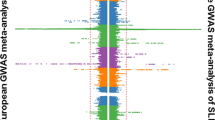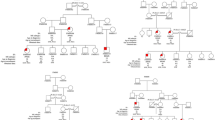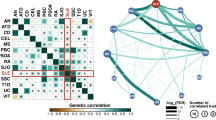Abstract
Systemic lupus erythematosus (SLE) appears to be the consequence of complex genetics and of only partly understood environmental contributions. Previous work by ourselves and by others has established genetic effects on 1q, 2q, 4p, 6p, and 16p using SLE as the phenotype. However, individual SLE affecteds are extraordinarily different from one another by clinical and laboratory measures. This variation may have a genetic basis; if so, it is advantageous to incorporate measures of between-family clinical variability as covariates in a genetic linkage analysis of affected relative pairs (ARPs) to allow for locus heterogeneity. This approach was applied to genome scan marker data from 160 pedigrees multiplex for SLE and containing 202 ARPs. Because the number of potential covariates was large, we used both ad hoc methods and formal principal components analysis to construct four composite covariates using the SLE classification criteria plus age of onset, ethnicity, and sex. Linkage analysis without covariates has detected evidence for linkage at 1q22–24, 2q37, 4p16, 12p12–11, and 17p13. Linkage analysis with these covariates uncovered linkage at 13p11, 17q11–25, and 20q12 and greatly improved evidence for linkage at 1q22–24, 2q37, 12p12–11, and 17p13. Follow-up analysis identified the original variables contributing to locus heterogeneity in each of these locations. In conclusion, allowing for locus heterogeneity through the incorporation of covariates in linkage analysis is a useful way to dissect the genetic contributions to SLE and uncover new genetic effects.
This is a preview of subscription content, access via your institution
Access options
Subscribe to this journal
Receive 6 digital issues and online access to articles
$119.00 per year
only $19.83 per issue
Buy this article
- Purchase on Springer Link
- Instant access to full article PDF
Prices may be subject to local taxes which are calculated during checkout

Similar content being viewed by others
References
Maddison PJ, Reichlin M . Deposition of antibodies to a soluble cytoplasmic antigen in the kidneys of patients with systemic lupus erythematosus Arthritis Rheum 1979 22: 858–863
Skinner RP, Maddison PJ . Analysis of polyethylene glycol precipitates from SLE sera: antibody enrichment in association with disease activity Clin Exp Rheumatol 1990 8: 553–560
Gladmann DD, Urowitz MD . Systemic lupus erythematosus: clinical features. In: Klippel JH, Dieppe PA (eds), Rheumatology Time Mirror International Publishers Ltd: London 1997
Tan EM, Cohen AS, Fries JF et al. The 1982 revised criteria for the classification of system lupus erythematosus Arthritis Rheum 1982 25: 1271–1277
Hochberg MC . Updating the American College of Rheumatology criteria for systemic lupus erythematosus Arthritis Rheum 1997 40: 1725
Blum A, Rubinow A, Galun E . Predominance of renal involvement in male patients with systemic lupus erythematosus Clin Exp Rheumatol 1991 9: 206–207
Ward MM, Studenski S . Systemic lupus erythematosus in men: a multivariate analysis of gender differences in clinical manifestations J Rheumatol 1990 17: 220–224
Molina JF, Drenkard C, Molina J et al. Systemic lupus erythematosus in males: a study of 107 Latin American patients Medicine 1996 25: 124–130
Jacobsen S, Petersen J, Ullman S et al. A multicentre study of 513 Danish patients with systemic lupus erythematosus. I. Disease manifestations and analyses of clinical subsets Clin Rheumatol 1998 17: 468–477
Mok CC, Lau CS, Chan TM, Wong RWS . Clinical characteristics and outcome of southern Chinese males with systemic lupus erythematosus Lupus 1999 8: 188–196
Jedrey CM, Olson JM, Gray-McGuire C, Bruner GR, Harley JB, Moser KL . Increased prevalence of renal disease in SLE families with affected males Arthritis Rheum 2002 46: 428–435
Goddard KAB, Witte JS, Suarez BK, Catalona WJ, Olson JM . Model-free linkage analysis with covariates confirms linkage of prostate cancer to chromosomes 1 and 4 Am J Hum Genet 2001 68: 1197–1206
Gray-McGuire C, Moser KL, Gaffney PM et al. Genome scan of human systemic lupus erythematosus by regression modeling: evidence of linkage and epistasis at 4p16–15.2 Am J Hum Genet 2000 67: 1460–1469
Gaffney PM, Ortmann WA, Selby SA et al. Genome screening in human systemic lupus erythematosus: results from a second Minnesota cohort and combined analyses of 187 sib-pair families Am J Hum Genet 2000 66: 547–556
Lindqvist AKB, Steinsson K, Johanneson B et al. A susceptibility locus for human systemic lupus erythematosus (hSLE1) on chromosome 2q J Autoimmun 2000 14: 169–178
Shai R, Quixmorio FP Jr, Li L et al. Genome-wide screen for systemic lupus erythematosus susceptibility genes in multiplex families Hum Mol Genet 1999 8: 639–644
Nair RP, Henseler T, Jenish S et al. Evidence for two psoriasis susceptibility loci (HLA and 17q) and two novel candidate regions (16q and 20p) by genome-wide scan Hum Mol Genet 1997 6: 1349–1356
Trembath RC, Clough RL, Rosbotham JL et al. Identification of a major susceptibility locus on chromosome 6p and evidence for further disease loci revealed by a two stage genome-wide search in psoriasis Hum Mol Genet 1997 6: 813–820
Tomer Y, Barbesino G, Greenberg DA, Concepcion E, Davies TF . A new Graves disease-susceptibility locus maps to chromosome 20q11.2. International Consortium for the Genetics of Autoimmune Thyroid Disease Am J Hum Genet 1998 63: 1749–1756
Moser KL, Neas BR, Salmon JE et al. Genome scan of human systemic lupus erythematosus: evidence for linkage on chromosome 1q in African-American pedigrees Proc Natl Acad Sci 1998 95: 14869–14874
Bias WB, Reveille JD, Beaty TH, Meyer DA, Arnett FC . Evidence that autoimmunity in man is a mendelian dominant trait Am J Hum Genet 1986 39: 584–602
Nath SK, Kelly JA, Namjou B et al. Evidence for a susceptibility gene, SLEV1, on chromosome 17p13 in families with vitiligo-related systemic lupus erythematosus Am J Hum Genet 2001 69: 1401–1406
Rao S, Olson JM, Moser KL et al. Linkage analysis of human systemic lupus erythematosus-related traits: a principal component approach Arthritis Rheum 2001 12: 2807–2818
Olson JM . Relationship estimation by Markov-process models in a sib-pair linkage study Am J Hum Genet 1999 64: 1464–1472
Klippel JH . Systemic lupus erythematosus: demographics, prognosis, and outcome J Rheumatol 1997 24): (Suppl 48): 67–71
Johnson RA, Wichern DW . Applied Multivariate Statistical Analysis Prentice Hall: Englewood Cliffs, New Jersey 1988
Whittemore AS, Tu I-P . Simple, robust linkage tests for affected sibs Am J Hum Genet 1998 62: 1228–1242
S.A.G.E. Statistical Analysis for Genetic Epidemiology, Release 4.0 A computer program package available from the Department of Epidemiology and Biostatistics, Case Western Reserve University, Cleveland, Ohio 2001
Holmans P . Asymptotic properties of affected-sib-pair linkage analysis Am J Hum Genet 1995 52: 362–374
Greenwood CMT, Bull SB . Analysis of affected sib pairs, with covariates—with and without constraints Am J Hum Genet 1999 64: 871–885
Author information
Authors and Affiliations
Corresponding author
Additional information
This work was supported in part by US Public Health Service grants HG01577 from the National Center for Human Genome Research, RR03655 and RR15577 from the National Center for Research Resources, AR42460 and AR45231 from the National Institute of Arthritis and Musculoskeletal and Skin Diseases, and AI24717 and AI31584 from the National Institute of Allergy and Infectious Diseases and the US Department of Veterans Affairs. The 101 pedigrees (Cohorts A, B, and C) were obtained from the Lupus Multiplex Registry and Repository (AR52221) (see http://mrf.ouhsc.edu/lupus). Some of the results in this paper were obtained using the program package SAGE, supported by US Public Health Service Resource Grant RR03655 from the National Center for Research Resources.
Rights and permissions
About this article
Cite this article
Olson, J., Song, Y., Dudek, D. et al. A genome screen of systemic lupus erythematosus using affected-relative-pair linkage analysis with covariates demonstrates genetic heterogeneity. Genes Immun 3 (Suppl 1), S5–S12 (2002). https://doi.org/10.1038/sj.gene.6363860
Received:
Revised:
Accepted:
Published:
Issue Date:
DOI: https://doi.org/10.1038/sj.gene.6363860
Keywords
This article is cited by
-
Genome-wide pathway analysis identifies VEGF pathway association with oral ulceration in systemic lupus erythematosus
Arthritis Research & Therapy (2017)
-
One novel susceptibility locus associate with systemic lupus erythematosus in Chinese Han population
Rheumatology International (2013)
-
Genome-wide linkage screen for stature and body mass index in 3.032 families: evidence for sex- and population-specific genetic effects
European Journal of Human Genetics (2009)
-
Fcγ receptors: structure, function and role as genetic risk factors in SLE
Genes & Immunity (2009)
-
Covariate-based linkage analysis: application of a propensity score as the single covariate consistently improves power to detect linkage
European Journal of Human Genetics (2006)



